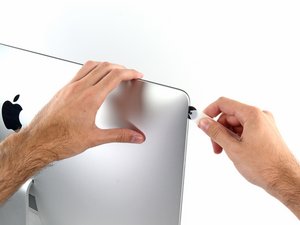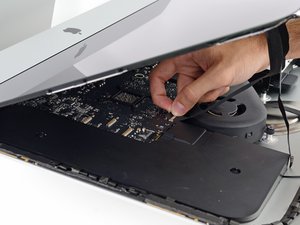By Sam Goldheart • Difficulty: Moderate
Follow this guide to replace the hard drive for your iMac. Replacing the hard drive requires separating the display and moving the left speaker.
This guide also includes steps to upgrade your iMac's hard drive with an SSD. It describes how to install the SSD's temperature sensor so that the Mac's fans will operate at the correct speed.
Before beginning any work on your iMac: Unplug the computer and press and hold the power button for ten seconds to discharge the power supply's capacitors.
Be very careful not to touch the capacitor leads or any exposed solder joints on the back of the power supply.

- With the hinge free to move, the iMac will be unbalanced and hard to work on. Repairs can be completed with the iMac laying down, but are faster and easier with an iMac service wedge.
- If you are using the iFixit cardboard service wedge, follow these assembly directions to put it together.



- Starting on the left of the display, near the power button, insert the iMac Opening Tool into the gap between the glass panel and the rear case.



- Use the tool like a pizza cutter—roll it along through the gap, and it will cut the foam adhesive through the center.
- Run the tool up along the left side of the display.



- Continue wheeling the tool up around the top left corner.


- Cut the adhesive along the top left of the display.


- Continue along the top of the display.



- Push the tool around the top right corner of the display.


- Wheel the tool down along the right side of the display.


- Finish pushing the opening tool to the bottom of the right side of the display.



- Set the iMac face-up on a table.
- Starting from the top right corner of the iMac, insert a plastic card between the display and frame.


- Gently twist the plastic card to open the space between the display and frame, and cut any remaining adhesive near the corner.



- Slide the card toward the center of the display, to cut any remaining adhesive.


- Put the card into the corner again and let it stay there to keep the adhesive from resettling.



- Insert a second card into the gap between the display and frame in the top left corner.


- Gently twist the card, slightly increasing the space between the display and frame.



- Slide the plastic card toward the center, again stopping just before the iSight camera.


- Insert the card back into the top left corner.



- With the cards inserted as shown near the corners, gently twist the cards to increase the gap between display and case.
- If there are any sections that seem to stick and won't separate, stop twisting and use one of the cards to cut the adhesive in the problem area.
- Begin to lift the top of the display up from the frame.


- While holding the display up with one hand, use the other to unplug the display power cable.



- Flip up the metal retaining bracket on the display data cable.
- Disconnect the display data cable.


- Lift the display up to a near-vertical position.
- Remove as much of the adhesive as possible by grabbing it at the outer edges, and then pulling or rolling it towards the middle.



- If necessary, a plastic card can be used to cut any remaining sections of the bottom adhesive strip.



- Lift the display up from the frame and remove it from the iMac. Lay the display face down on a flat, soft surface.
- It may be necessary to slowly lift from one side, to peel against the remaining adhesive.

- If there is a wire or cable underneath adhesive tape, always pull the tape off first.
- If the cable is glued to the chassis, use a heated iOpener or a hair dryer to soften the adhesive first. You can then slide an opening pick underneath the cable to loosen it. Never pull directly on the delicate connectors.
- Slide an opening pick underneath the foam cushion pieces to separate them from the display, and gently pull them off. You may need some double sided tape to re-attach them to the new display.

- Use a T10 driver to remove the two 10 mm screws securing the left speaker.


- Shift the loosened left speaker to the left—enough to uncover the hard drive bracket screws.


- Pull straight up on the SATA combo cable to disconnect it from the drive.

- Use a T8 driver to remove the two 7.3 mm screws securing the left hard drive bracket to the rear case.



- Grab the hard drive and left hard drive bracket together.
- Tilt the left side away from the rear case, and slide the assembly to the left.
- Remove the hard drive and left hard drive bracket from the iMac.


- Remove the left hard drive bracket.

- Remove the four 8.1 mm T8 screw posts from the hard drive, and transfer them to the replacement drive enclosure.



- Line up the SSD connectors with the metal enclosure's sockets.
- Press the drive against the enclosure sockets until the SSD is firmly seated.



- Use a Phillips screwdriver to install the four silver screws (two on each side) along the edges of the SSD to secure it to the enclosure.


- Plug the included sensor-enabled combo cable into the enclosure's port.



- Peel the white liner off the back of the small temperature sensor board in order to expose the adhesive.
- Adhere the temperature sensor board to an exposed, metal surface of the SSD, close to the SATA connector.
- Fold the excess temperature sensor wires so that they are out of the way while you install the enclosure.


- Use a T8 driver to install the mounting pins from the old hard drive onto the sides of the enclosure.


- Attach any mounting brackets removed from the old hard drive onto the enclosure.


- Connect the iMac's combo cable to the new temperature-enabled combo cable.



- Slide the SSD enclosure into the space previously occupied by the hard drive.
- Route the cables so that they will not interfere with any other components.
To reassemble your device, follow these instructions in reverse and use our Adhesive Strips Guide to reattach the display glass.
Take your e-waste to an R2 or e-Stewards certified recycler.
Repair didn’t go as planned? Try some basic troubleshooting, or ask our Answers community for help.